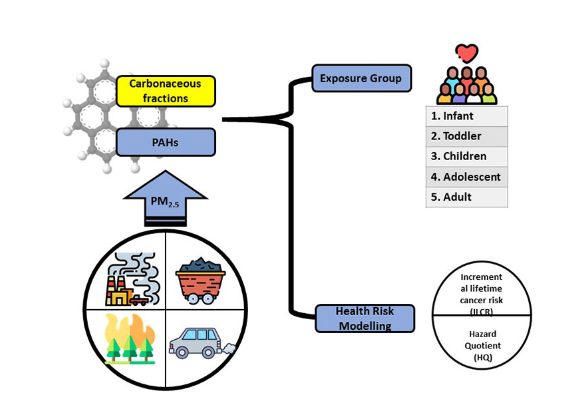With increasing interest in understanding contribution of secondary organic aerosol (SOA) to particulate air pollution in urban areas, an exploratory study was carried out to determine levels of carbonaceous aerosols and polycyclic aromatic hydrocarbons (PAHs) in the City of Kuala Lumpur, Malaysia. PM2.5 samples were collected using a high-volume sampler for 24 h in several areas in Kuala Lumpur during the north-easterly monsoon from January to March 2019. Samples were analysed for water soluble organic carbon (WSOC), organic carbon (OC), elemental carbon (EC) and secondary organic carbon (SOC) in PM2.5 was estimated. Particle-bound PAHs were analysed using gas chromatography-flame ionization detector (GC-FID). Average concentrations of WSOC, OC and EC were 2.7 ± 2.2 (range of 0.63-9.1) µg/m3, 6.9 ± 4.9 (3.1-24.1) µg/m3 and 3.7 ± 1.6 (1.3-6.8) µg/m3, respectively, with estimated average SOC of 2.3 µg/m3, contributing 34% to total OC. The average of total PAHs was 1.8 ± 2.7 ng/m3. Source identification methods revealed natural gas and biomass burning, and urban traffic combustion as dominant sources of PAHs in Kuala Lumpur. To understand human health risk posed by PAHs, a deterministic screening health risk assessment was also conducted for several age groups including infant, toddler, children, adolescent and adult. The total concentration of BaPeq is 3.8 ng/m3, with the average of 0.29 (range of 0.001-1.6) ng/m3. Carcinogenic and non-carcinogenic risk of PAH species were well below the acceptable levels recommended by the USEPA. Future work is needed using long-term monitoring data to understand the origin of PAH contributing to SOA formation and to apply source-risk apportionment to know better the potential risk factors posed by the various sources in urban areas in Kuala Lumpur.

